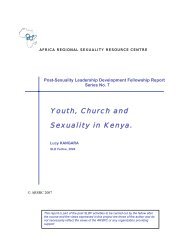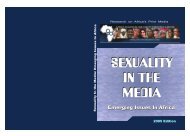body images beauty culture and language - Africa Regional ...
body images beauty culture and language - Africa Regional ...
body images beauty culture and language - Africa Regional ...
Create successful ePaper yourself
Turn your PDF publications into a flip-book with our unique Google optimized e-Paper software.
preparations. Ironically, some with a natural fair tint still pursue an even ‘whiter’<br />
pigmentation. The Yoruba term, àmúlúmàlà, with its negative connotation is specifically<br />
suited to the often not so pleasant pigment outcomes of the craze for fair skin. The “high<br />
value on white skin” <strong>and</strong> the fact that “skin bleaching products are ‘everywhere’” 17 is<br />
often alluded to with a subtext of pride by western commentators, <strong>and</strong> it is obviously not<br />
peculiar to Nigeria.<br />
What is being witnessed today in this regard a resurgence of a similar craze in the early<br />
60s in Nigeria which met with stiff societal resistance at the time. The slang that became<br />
very popular in the description of the female with altered pigment then was: soyoyo adiye<br />
abolorun, a term that was popularized by the apala musician Haruna Ishola in the early<br />
seventies. Soyoyo – onomatopoeic for fake or contrived fairness - <strong>and</strong> adiye abolorun –<br />
implying the bloodied <strong>and</strong> unseemly pigment that shows when a chicken’s feathers are<br />
pulled out round the neck – carry negative connotations. The message in Haruna Ishola’s<br />
song was however an ambivalent mixture of praise <strong>and</strong> criticism. It was Fela Anikulapo’s<br />
Yellow Fever (1972), which incidentally was more internationally renowned, that was<br />
unambiguously caustic <strong>and</strong> it instilled public consciousness with a criticism of<br />
cosmetically altered pigmentation. A later slang for persons sporting such àmúlúmàlà<br />
skin mix in Nigerian popular <strong>culture</strong> is ‘fanta face cocacola bottom,’ which tries to<br />
capture the same negative connotation. Clearly, we have a racial/cultural contest<br />
manifesting in resistance to what is considered a negative <strong>body</strong> image <strong>and</strong> reflecting in<br />
<strong>language</strong> use. Still, it is unclear whether the crave for a lighter pigment has subsided or is<br />
experiencing a resurgence through contemporary media <strong>images</strong>.<br />
Lepa Sh<strong>and</strong>y vs ỌÃrọÃmbọÃ<br />
The popular plump figure of traditional female <strong>body</strong> image makes the occasional<br />
appearance in media projections (Image 6), but the most projected image is that of the<br />
slim <strong>body</strong> (Image 7). Lepa sh<strong>and</strong>y is contemporary slang among the youths (<strong>and</strong><br />
sometimes the ‘young at heart’) for the female sexual <strong>body</strong> so projected. The health<br />
hazards involved in the attempt by many to approximate this lepa sh<strong>and</strong>y image of<br />
17 ‘M<strong>and</strong>y’ http://www.blogger.com/post-edit.g?blogID=18789442&postID=114904612478212163






